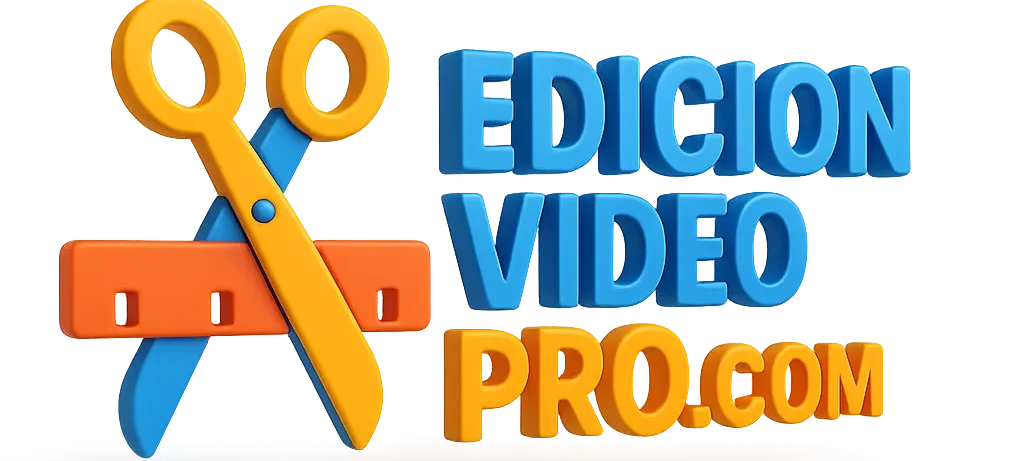Free Stock Videos: Download B-Roll Footage in HD/4K
Free Stock Videos: Where to Download Professional B-Roll Footage in 2025
Need to download free stock videos for your project but don’t know where to start? You’re in the right place. Whether your B-roll footage ran short or you simply need to supplement with shots you didn’t capture yourself, free stock footage can be a lifesaver for creators on any budget.
But here’s the catch: not all stock video sites are created equal. Some have terrible quality, others have hidden fees, and many have confusing licenses that could land you in legal hot water if you use them commercially without proper clearance.
In this comprehensive guide, we’ll show you the best platforms for downloading royalty-free stock footage, explore the exciting new world of AI-generated video content, explain licensing in plain English (no legal jargon), and teach you how to search effectively so you’re not wasting hours scrolling.
Everything explained simply, just like we do at EdicionVideoPro.
💡 New to this? First, learn what B-roll is and how to use it effectively to maximize these resources.
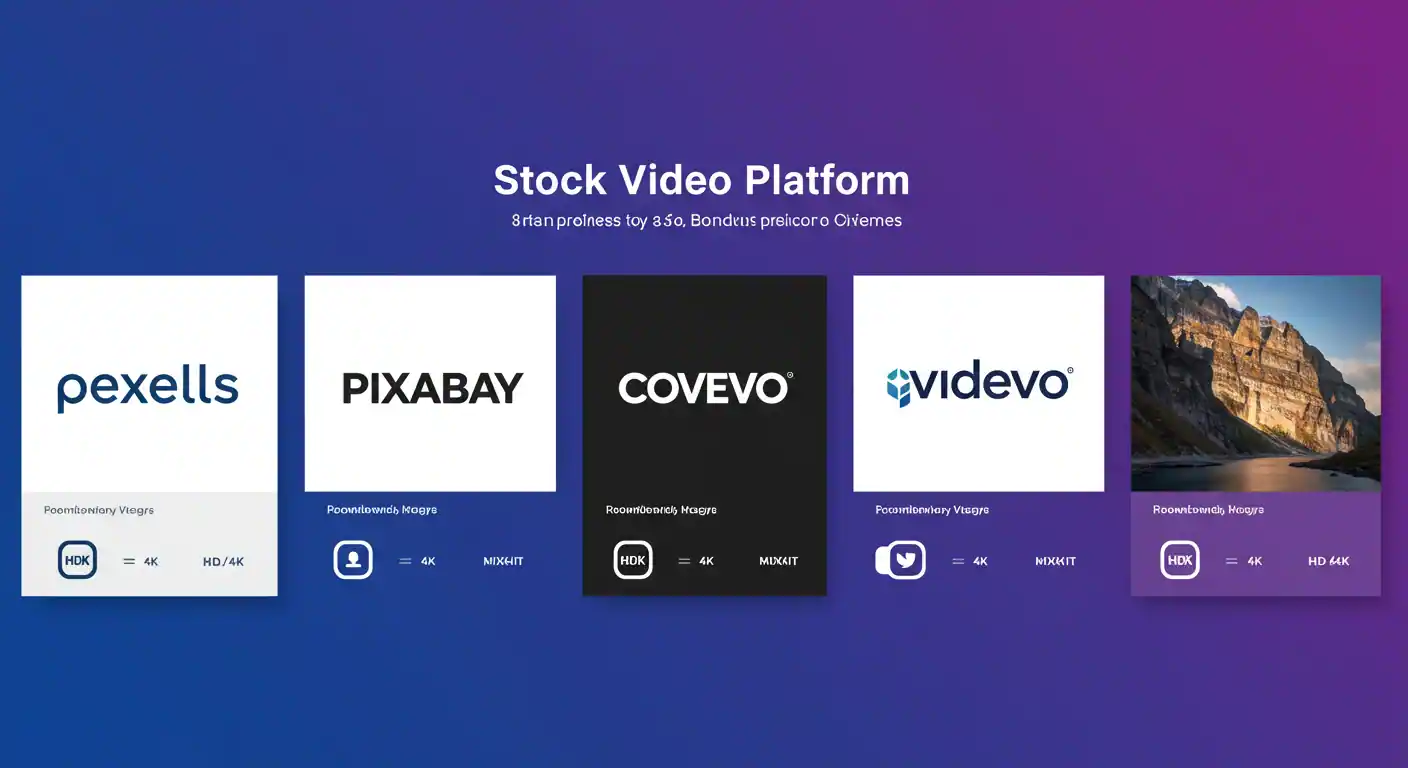
🏆 Top 7: Best Sites for Free Stock Videos (2025)
Here’s the definitive list of traditional stock footage platforms, thoroughly tested by our team. We’ve ranked them by quality, ease of use, and library size:
1. 🥇 Pexels Videos – Best Overall Choice
- Quality: HD and 4K on almost everything
- Library Size: 100,000+ videos
- License: Completely free (even commercial use)
- Registration: Not required to download
- Best For: Smart search features, curated collections
- Downside: Popular clips appear in many projects
👉 Ideal for: Any project type, especially YouTube videos and Instagram Reels content.
2. 🥈 Pixabay – Massive Library, Variable Quality
- Quality: From HD to 4K (very inconsistent)
- Library Size: 2.9+ million videos
- License: Pixabay License (similar to public domain)
- Registration: Not required
- Best For: HUGE selection of options
- Downside: Requires heavy filtering, lots of amateur content
👉 Ideal for: When you need something super specific that you can’t find elsewhere.
3. 🥉 Coverr – Social Media Specialist
- Quality: HD optimized for web
- Library Size: ~1,000 curated videos
- License: Free commercial use
- Registration: No
- Best For: Everything available in vertical/horizontal formats, perfect for social
- Downside: Limited library
👉 Ideal for: TikTok videos and YouTube Shorts.
4. Videvo – Free + Premium Mix
- Quality: HD and 4K
- Library Size: 500,000+ (partially free, partially paid)
- License: Varies by clip (read carefully before downloading)
- Registration: Yes, required for free downloads
- Best For: Also includes motion graphics and After Effects templates
- Downside: Confusing to distinguish what’s free vs. paid
5. Mixkit – High-Quality Curated Collections
- Quality: Mostly 4K
- Library Size: ~5,000 handpicked clips
- License: Mixkit License (commercial use OK)
- Registration: No
- Best For: Consistently high quality, well-organized categories
- Downside: Fewer options than competitors
6. Life of Vids – Artistic Style
- Quality: HD
- Library Size: ~200 videos
- License: CC0 (public domain)
- Registration: No
- Best For: Very artistic and cinematic style
- Downside: VERY limited quantity
7. Mazwai – Cinematic Quality
- Quality: HD/4K cinematic
- Library Size: ~300 clips
- License: CC 3.0 (some require attribution)
- Registration: No
- Best For: Documentary/film production quality
- Downside: Very small library
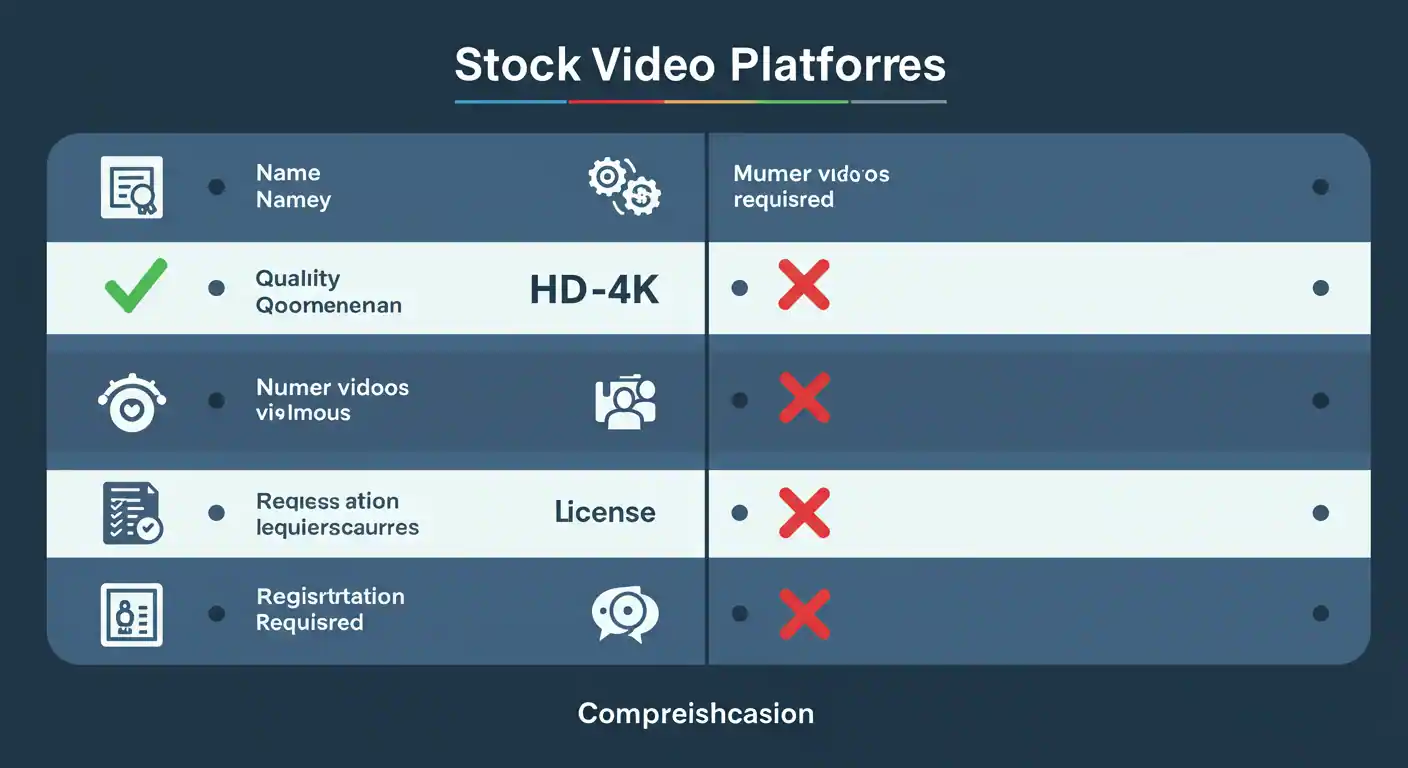
💰 Worth Paying For? Top Premium Platforms
If you’re producing content regularly, these subscriptions pay for themselves quickly. Our top picks:
Artgrid – $299/year (Our #1 Choice)
- ✅ True cinematic quality
- ✅ Unique clips (won’t see them in 1000 other videos)
- ✅ Unlimited downloads
- ✅ Perpetual license (use forever)
Recommended for: Wedding videos, premium corporate content, documentaries.
Envato Elements – $16.50/month
- ✅ 2.8+ million videos
- ✅ Includes music, templates, photos, fonts
- ✅ Best price-to-value ratio
Recommended for: Creators who need multiple resources (not just video). Also offers legal music for your projects.
Storyblocks – $29/month
- ✅ Unlimited downloads
- ✅ Good for generic corporate content
- ⚠️ Variable quality
🤖 The New Revolution: AI-Generated Video Content
In 2025, we have a revolutionary alternative to traditional stock: creating videos from scratch using artificial intelligence. Sounds like science fiction, but it’s very real and changing the game for many creators.
What Are AI Video Generation Platforms?
These are tools that generate videos from text descriptions (text-to-video) or transform images into video (image-to-video). Type “sunset on the beach with gentle waves slow motion” and the AI creates that video in minutes.
Sounds perfect, right? Well… it has significant pros and cons. Let’s be honest so you can decide if it’s right for you:
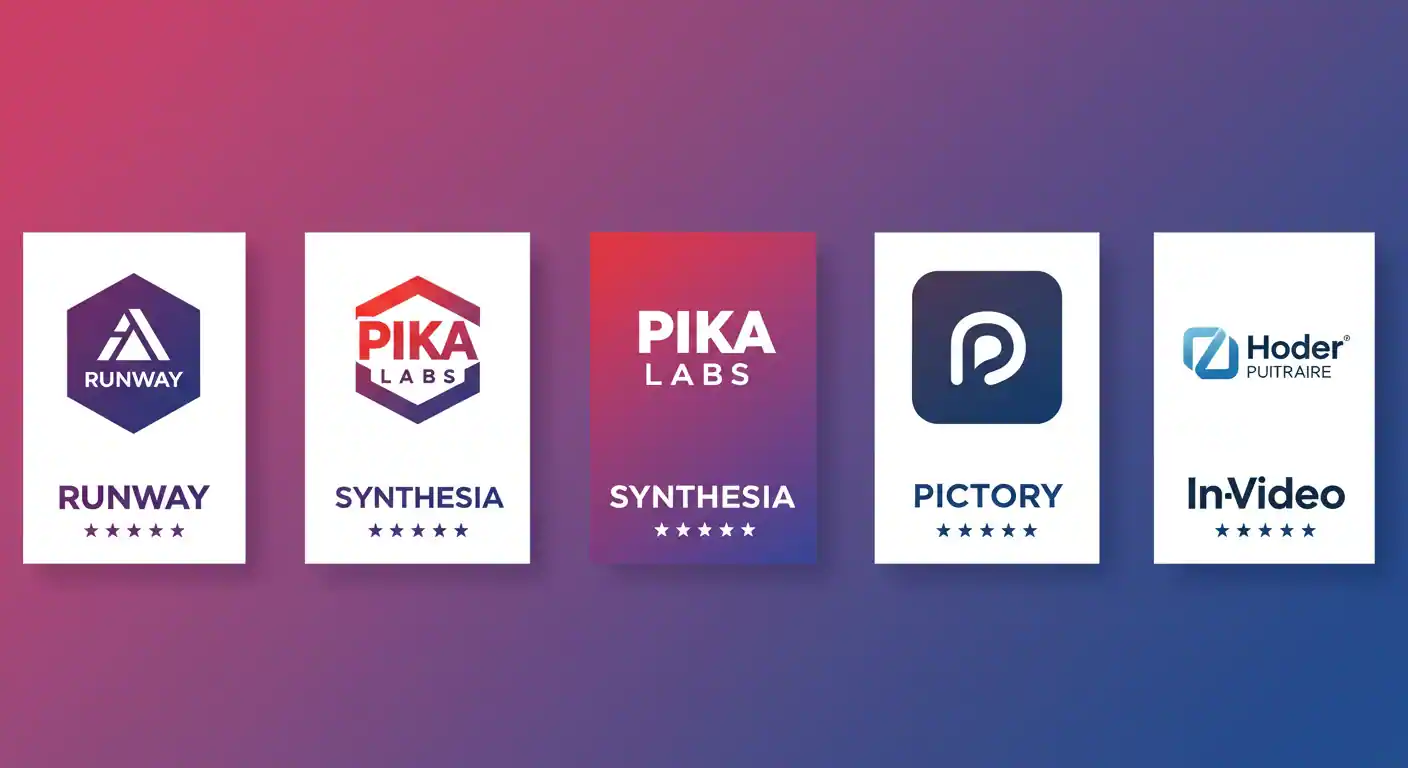
🎯 Top 5 AI Video Platforms (2025)
1. Runway Gen-3 – Most Advanced
- Pricing: From $12/month (95 credits) to $76/month
- Quality: 4K, up to 10 seconds per clip
- Best For: Most realistic quality on the market, precise control
- Downside: Expensive if generating frequently, learning curve
✅ Use it if: You need cinematic quality and have the budget
❌ Avoid if: You’re a beginner or need to generate many clips daily
2. Pika Labs – Price/Quality Balance
- Pricing: Limited free plan, $10/month basic, $35/month pro
- Quality: HD, up to 3 seconds free / 8 seconds premium
- Best For: Super simple interface, fast results
- Downside: Short videos, less creative control
✅ Use it if: You want to try AI without financial commitment
❌ Avoid if: You need longer clips (10+ seconds)
3. Synthesia – AI Presenter Specialist
- Pricing: From $29/month (120 minutes/year)
- Quality: Full HD, human avatars speaking
- Best For: Create videos with “people” talking without filming anything
- Downside: Only avatars, not landscapes or objects
✅ Use it if: You need corporate videos, tutorials, presentations
❌ Avoid if: You’re looking for B-roll of nature, objects, locations
4. Pictory – AI for Editing Existing Videos
- Pricing: From $19/month
- Quality: Depends on source material
- Best For: Converts articles/scripts into videos automatically
- Downside: Doesn’t generate footage, only organizes and edits
✅ Use it if: You have written content and want to automate editing
❌ Avoid if: You need to generate footage from scratch
5. InVideo AI – All-in-One for Social
- Pricing: Limited free plan, $20/month plus
- Quality: HD, optimized for social media
- Best For: Creates complete videos with script, music, transitions
- Downside: Very template-based, obviously AI
✅ Use it if: You need volume for social media fast
❌ Avoid if: You want unique, personalized content
⚖️ AI vs Traditional Stock: Honest Comparison
Here’s the unfiltered truth so you can decide what works for your specific project:
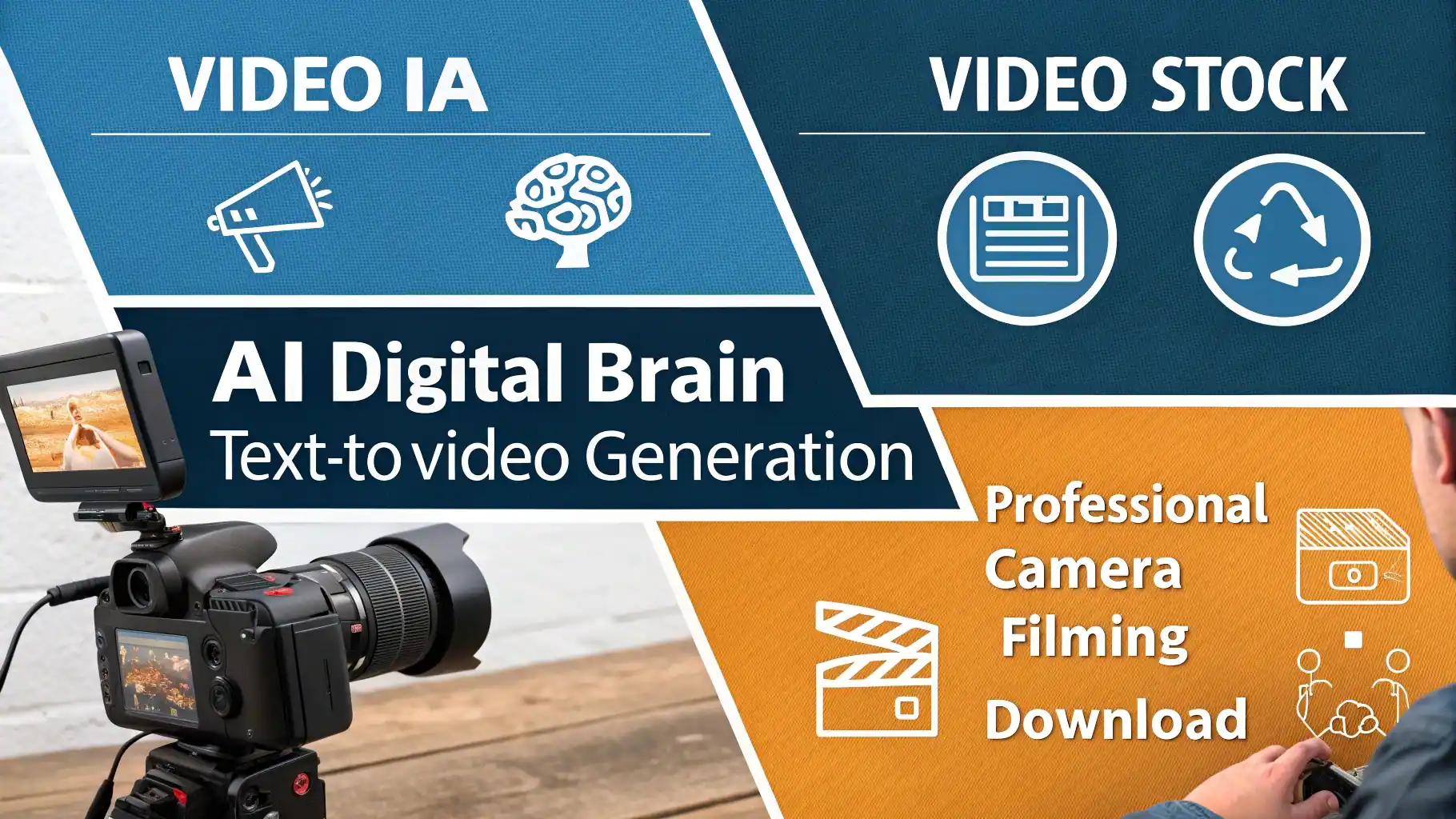
🤖 ADVANTAGES of AI-Generated Videos:
- ✅ 100% unique content: Nobody else has that exact video
- ✅ Total creative control: Describe exactly what you want
- ✅ Generate the impossible: Scenes that don’t exist in stock (e.g., “astronaut surfing on Saturn”)
- ✅ No licensing limits: What you generate is yours
- ✅ Rapid iteration: Don’t like it? Regenerate with small tweaks
- ✅ No equipment needed: No camera or lighting required
🚫 DISADVANTAGES of AI-Generated Videos:
- ❌ Pay per use: Each generation consumes credits ($$$)
- ❌ Inconsistent quality: Sometimes perfect, sometimes terrible
- ❌ Time to experiment: You need to learn “prompt engineering”
- ❌ Short videos: Most limit to 3-10 seconds per generation
- ❌ Strange artifacts: Six-fingered hands, weird physics, visual glitches
- ❌ Still obviously AI: Especially in human movements
- ❌ No fine control: You can’t adjust the exact outcome
- ❌ Ethical and legal gray areas: Still being debated in many jurisdictions
📹 ADVANTAGES of Traditional Stock:
- ✅ Free or very cheap: Thousands of options at $0
- ✅ Guaranteed quality: You know exactly what it looks like before using
- ✅ Download and use: No experimentation, no waiting
- ✅ Longer videos: Clips from 30 seconds to several minutes
- ✅ 100% realism: Real footage filmed professionally
- ✅ No learning curve: Search and download is intuitive
- ✅ Legally safe: Clear, established licenses
🚫 DISADVANTAGES of Traditional Stock:
- ❌ Limited to what exists: If nobody filmed it, it doesn’t exist
- ❌ Others use it too: Popular clips appear in thousands of videos
- ❌ Sometimes generic: Especially corporate/office footage
- ❌ Licenses to read: Must verify what you can do
- ❌ May not match your style: Different color, filming style
🎯 Which Should You Choose? Quick Decision Guide
Use this mental flowchart to decide in seconds:
Choose TRADITIONAL STOCK if:
- 💰 You have zero or very limited budget
- ⏰ You need the video NOW (urgent)
- 👥 Your project needs real people acting naturally
- 🎥 You’re looking for real-life scenes (cities, nature, events)
- 📚 You’re just starting and don’t want complications
- 🎬 You need longer clips (15+ seconds)
- ✅ You find exactly what you need on free platforms
Best option: Start with Pexels (free) → If you need more, try Envato Elements ($16.50/month)
Choose AI if:
- 🎨 You need something super specific that doesn’t exist in stock
- 🚀 You want 100% unique, differentiated content
- 💡 You create conceptual/artistic/futuristic content
- 🔄 You produce lots of content and the cost is justified
- ⚡ You enjoy experimenting with new technology
- 🎭 You need impossible scenarios/fantasy/sci-fi
- 💵 You have budget for monthly subscription ($20-75/month)
Best option: Start with free plan of Pika Labs → If convinced, upgrade to Runway Gen-3
🏆 The Hybrid Strategy (Our Recommendation):
Most professional creators combine both based on each scene’s specific needs:
- Stock for: Establishing shots, real people, nature, events
- AI for: Special effects, unique transitions, abstract concepts, fantasy
- Original for: Your main specific content and personal brand
Practical example: Video about “workplace productivity”:
- 🎥 Stock: Person working on laptop, modern office, coffee being poured
- 🤖 AI: Abstract visualization of “workflow” (gears, flowing energy, connection graphs)
- 📹 Original: Your on-camera presentation explaining specific tips
💡 Pro Tip: If using AI, apply professional color grading and match colors with your other footage for seamless integration.
⚠️ Legal & Ethical Considerations (Important)
Before diving into AI, you need to know this:
- YouTube and monetization: YouTube allows AI-generated videos, BUT you must mark it as “synthetic content” in video settings. Failing to do so can result in strikes.
- Deepfakes and real people: Using AI to create videos of real people without permission is illegal in many countries and can get you into serious legal trouble.
- Intellectual property: Legal debate is still ongoing. Some platforms give you full rights, others maintain shared rights. Read the terms.
- Audience transparency: Consider informing your audience if you use generative AI, especially in educational, journalistic, or documentary content. Trust is key.
- Terms of service: Read carefully. Some platforms may use your generations to train their future AI.
- Industry limitations: Some sectors (medical, legal, financial) have strict regulations about AI-generated content.
Our recommendation: Traditional stock remains the safest option legally and ethically. Use AI as a creative complement for specific elements, not as your content’s total foundation.
⚖️ Stock Licenses Explained (Plain English, No Legal Jargon)
Here’s what you REALLY need to know about royalty-free video licenses. No complications:
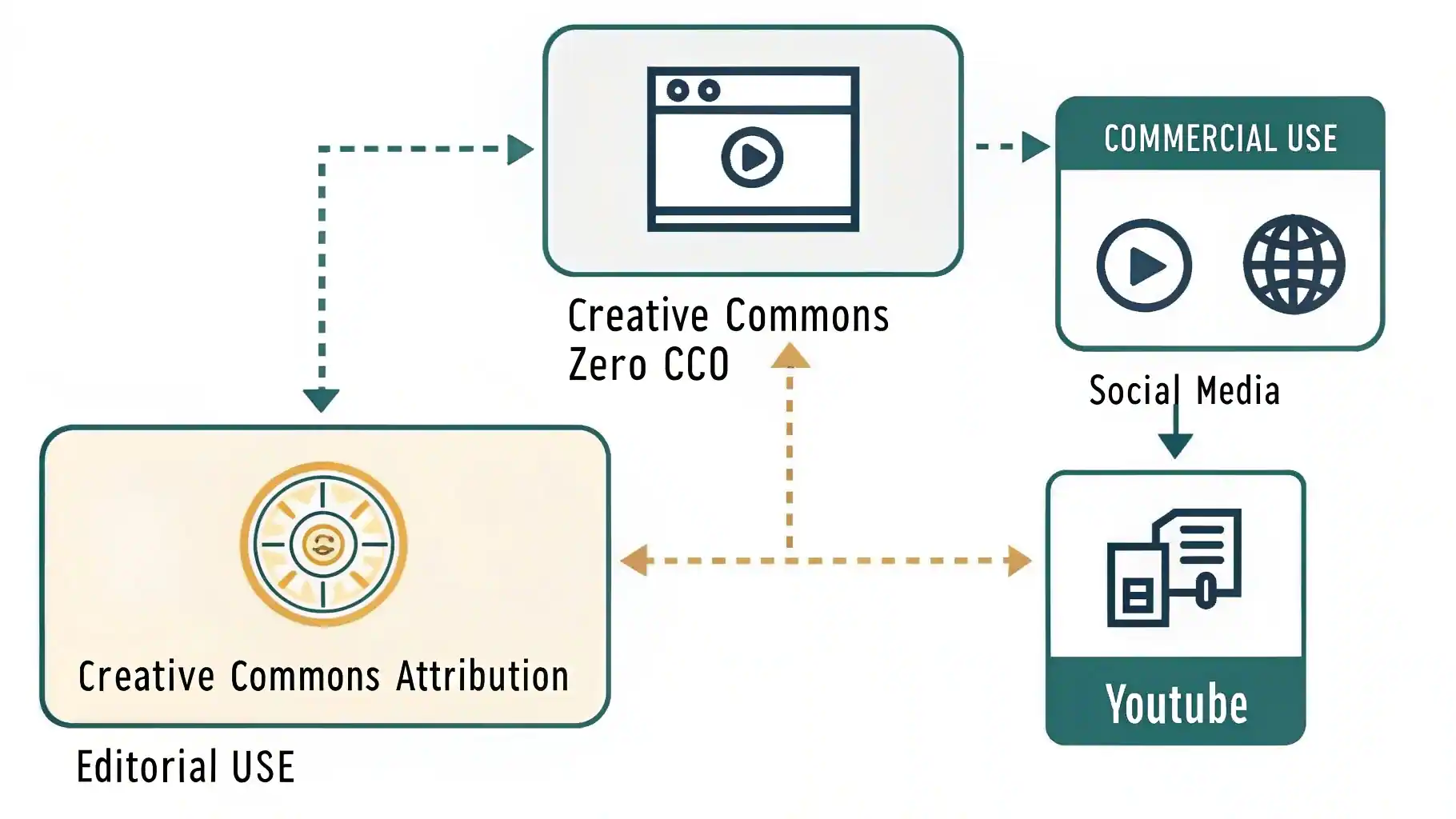
🟢 CC0 (Creative Commons Zero) = Full Green Light
- ✅ Use however you want (personal, commercial, YouTube, ads, products)
- ✅ No attribution needed to the creator
- ✅ Edit it however you want
- ✅ Resell your final project without issues
- ✅ Monetize on any platform
Platforms with CC0: Pexels, Pixabay, Mixkit
🟡 CC BY (Creative Commons Attribution) = Yellow Light
- ✅ Commercial use OK
- ⚠️ MUST credit the creator (name + link if possible)
- ✅ Can edit and modify
- ✅ Can monetize
How to credit properly:
- In video end credits: “Video by [Creator Name] via [Platform]”
- In YouTube/social description: “B-roll courtesy of [Name] – [Link if applicable]”
🔴 Editorial Use = News/Education Only
- ❌ NO for commercial use
- ❌ NO for ads or promotions
- ❌ NO for selling products/services
- ✅ Only for news, documentaries, education, critique
⚠️ Critical: Always verify the specific license of the clip you download. It can vary even within the same platform. When in doubt, don’t use it commercially.
🔍 How to Search Stock Videos Like a Pro
Don’t search “office video”. That’ll get you generic garbage. Follow these proven tips:
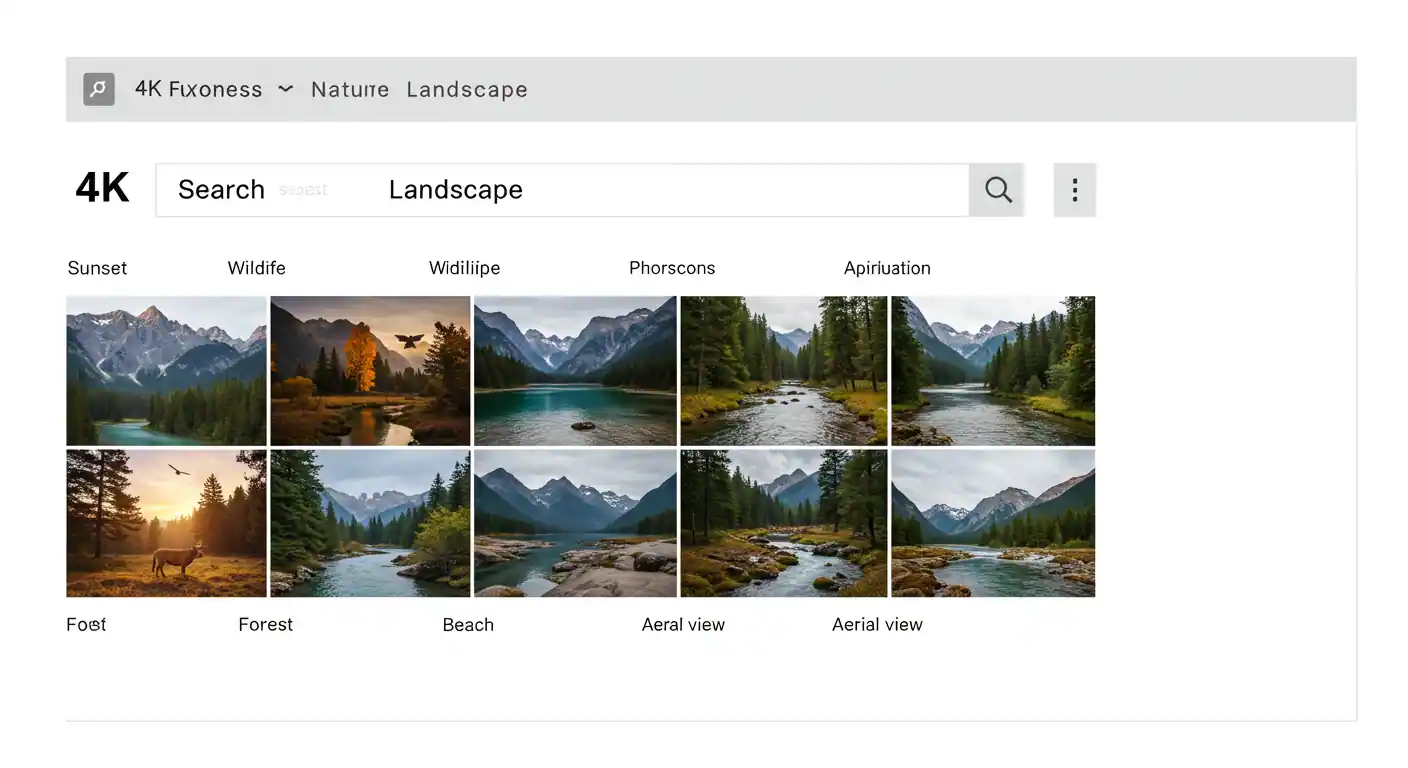
1. Use Specific, Concrete Keywords
- ❌ Bad: “nature”
- ✅ Good: “forest mist sunrise pine trees”
- ❌ Bad: “technology”
- ✅ Good: “hands typing laptop closeup 4k”
- ❌ Bad: “food”
- ✅ Good: “pasta carbonara being served slow motion”
2. Master the Filters
- Orientation: Horizontal (16:9) for YouTube/TV, Vertical (9:16) for Reels/TikTok/Shorts
- Resolution: Minimum HD (1920×1080), ideally 4K if your project supports it
- Duration: 5-15 seconds is most useful for typical B-roll
- Frame rate: 24fps for cinematic look, 30fps for corporate, 60fps if you want to do slow motion
3. Explore Curated Collections
Instead of searching clip by clip, many platforms have pre-organized thematic collections (e.g., “Workspace vibes”, “Urban sunset”, “Cooking closeups”). Saves massive time.
4. Download More Than You Need
If you find good related clips, download 3-5 similar variations. You’ll thank yourself in editing when you need options.
5. Search by Camera Movement
- “drone aerial” – Drone shots
- “tracking shot” – Camera following subject
- “dolly” – Smooth camera movement
- “time lapse” – Time lapse
- “slow motion” – Slow motion
💡 Pro Tip: Apply principles of professional visual composition when evaluating if a stock clip will work for your project before downloading.
✅ Good vs 🚫 Bad Uses of Stock Footage
Not everything works. Here’s how to tell when stock works and when it screams “cheap and generic”:
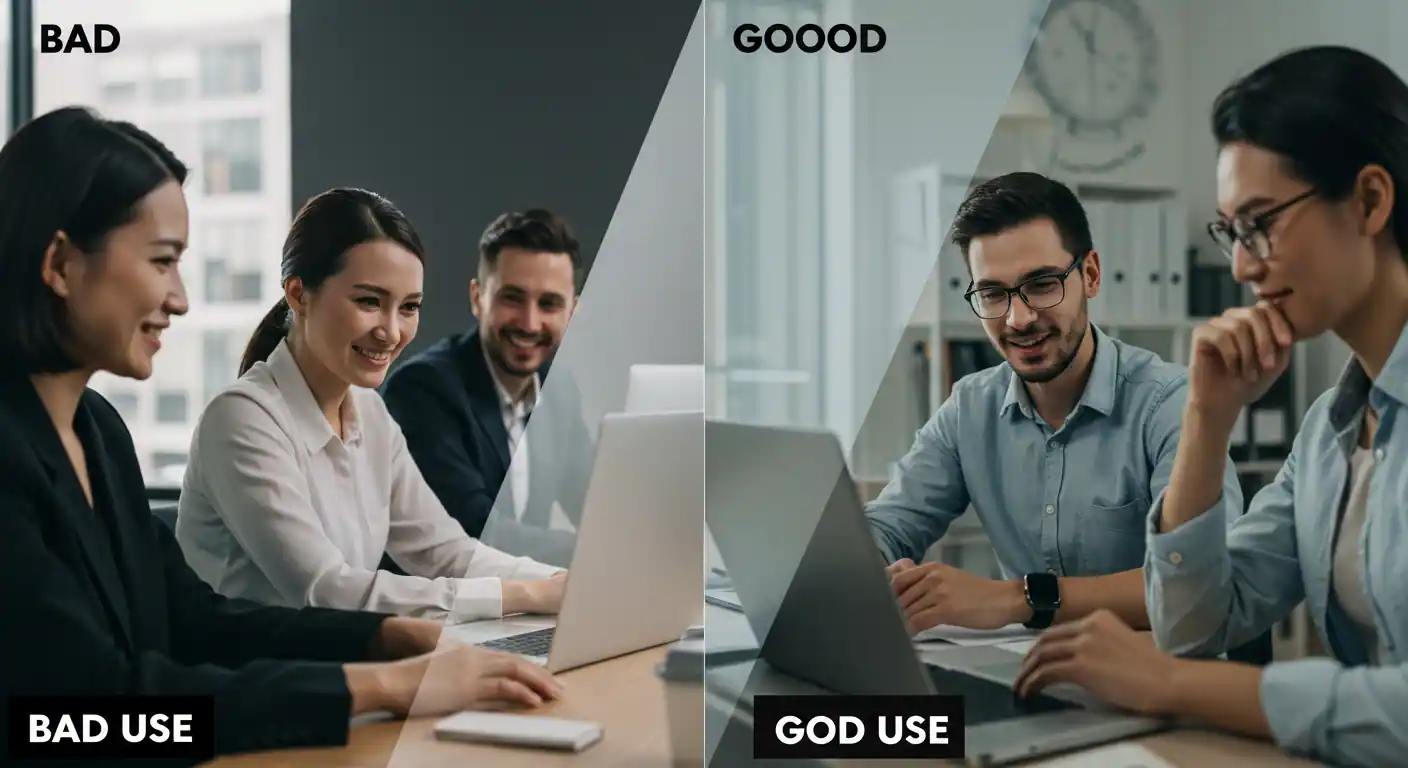
🚫 BAD USE (Avoid at All Costs):
- Super generic corporate stock: “People in suits smiling at laptop in fake office with perfect lighting”. Noticeable from a mile away and kills credibility. Your audience has seen it a thousand times.
- Technically doesn’t match your footage: Your phone-shot video in 1080p at 30fps + 4K cinematic stock at 24fps = horrible quality difference.
- Completely different lighting/color: Your interview has warm natural light and you insert stock with cold artificial LED light. Breaks all visual cohesion.
- Totally irrelevant or forced: Talking about “digital marketing strategy” while showing generic clips of rising arrows, context-free graphs and handshakes. Boring, predictable, no value.
- Same clip everyone uses: There are VERY popular clips (that businessman looking at city from window) that are literally in thousands of videos. Your audience recognizes them instantly.
- Jarring transition: Stock of very different quality intercutting without smooth transition.
✅ GOOD USE (Do This):
- Impossible establishing shots: Cities, landscapes, international locations you couldn’t film yourself that provide context.
- Well-integrated authentic complement: Stock that blends naturally with your own footage without noticeable source difference.
- Professionally applied color matching: Adjust color, exposure and look of stock to perfectly match your project. Learn how to color match different sources.
- Specific and directly relevant: If talking about “arabica coffee beans”, show EXACTLY arabica coffee beans in closeup, not a generic steaming cup.
- Unique/less-used stock: Search less popular platforms (Mazwai, Life of Vids) or newer clips not yet saturated.
- Time-lapses and nature: Where stock really shines. Nobody has time/equipment to shoot an 8-hour time-lapse of the city or Milky Way.
- Special effects and VFX: Explosions, smoke, particles, elements requiring costly production.
Absolute golden rule: If your viewer can consciously or subconsciously think “this is generic stock,” you failed. It must integrate invisibly into your visual narrative.
🎨 How to Integrate Stock Into Your Edit Professionally
You’ve downloaded the clips. Now comes the critical part: making it not look like stock.
- Unified color grading: All clips (yours + stock + AI) must have the same look and feel. Use the same LUT or color adjustments on everything. This is CRITICAL.
- Match frame rate: If your footage is 24fps, convert or interpolate stock to also be 24fps. Mixing frame rates is noticeable.
- Subtle speed ramping: Sometimes slightly speeding up (105-110%) stock makes it feel more dynamic and unique, less “recognizable”.
- Strategic crop/reframe: If stock framing isn’t perfect, digitally zoom or crop. Change composition to make it feel more yours.
- Texture or grain overlay: A subtle layer of film grain or vintage texture can help unify material from different sources and give cohesion.
- Appropriate sound design: Add appropriate ambient sound to stock. Footage without sound design feels dead and disconnected.
- Subtle transitions: Use J-cuts and L-cuts for smoother transitions between your footage and stock.
👉 Master all these techniques in depth with our complete guide to professional post-production workflow.
💡 Software Tip: Learn to integrate stock perfectly in your favorite editor:
❓ Frequently Asked Questions About Stock Videos & AI
Can I monetize YouTube videos with free stock footage?
Yes, absolutely, if the license is CC0 or explicitly allows commercial use. Pexels, Pixabay and Mixkit are perfect for monetization on YouTube, Instagram, TikTok and any platform. Just make sure to read the specific license of the clip before using it.
Do I need to credit the stock video creator?
Depends on the license. CC0 = No credit needed (though it’s a nice gesture). CC BY = You MUST credit in end credits or description. Always verify the specific license of each clip.
Can I use the same clip in multiple projects?
On free platforms with CC0: Yes, unlimited projects. On premium platforms with subscription: generally yes while you have active subscription, but read specific terms. Some services require active subscription to continue using downloaded clips.
What happens if I use stock without proper license or violate terms?
Real consequences: they can take down your video, block your account, claim monetization revenue, or in extreme cases, sue you. Not worth the risk. Use ONLY what has clear, appropriate license for your use.
Is paying for stock worth it if I produce content regularly?
If you produce 2+ videos per month: definitely YES. $16-30/month pays for itself in time saved, superior quality and unique less-seen clips. For very occasional projects (1 video every 3 months), free is perfectly sufficient.
Is AI better than traditional stock?
There’s no one-size-fits-all answer. Stock is better for realism, real people, natural scenes, limited budget and urgent projects. AI is better for unique content, abstract concepts, impossible scenarios and when you have budget to experiment. Most professionals use a hybrid strategy combining both based on specific scene needs.
Do AI-generated videos have copyright?
Legal gray area currently. Most AI platforms grant you commercial rights to what you generate, but traditional copyright is tricky since there’s no “human author”. Consult a lawyer if this is critical for your case. For general use on social/YouTube, it’s normally OK.
🎯 Your Action Plan: Start Today
You now have all the knowledge to download professional free stock videos and decide between traditional stock and AI. Here’s your immediate action checklist:
- ✅ Start with Pexels (best for beginners, 100% free, high quality)
- ✅ ALWAYS read the license before using any clip (5 seconds that save you problems)
- ✅ Download 3-5 variations of each shot type you need (more editing options)
- ✅ Unify color of all your clips in post-production (critical for cohesion)
- ✅ If producing 2+ videos/month, consider Envato Elements ($16.50/month, worth every penny)
- ✅ If you want to experiment with AI, start with Pika Labs free plan
Next level mastery:
- → Learn to combine stock with your own footage: Essential video editing guide
